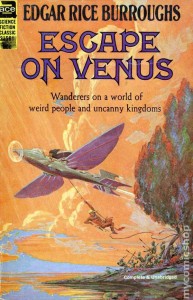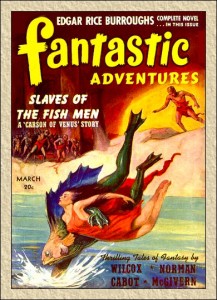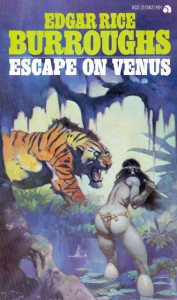 This installment was published in Fantastic Adventures between 1941 and 1942 just as our world was readying itself for a global war, and elements of this certainly slip into Burroughs’ writings.
This installment was published in Fantastic Adventures between 1941 and 1942 just as our world was readying itself for a global war, and elements of this certainly slip into Burroughs’ writings.In Escape on Venus Carson Napier and the lovely Duare seem even more cursed with “adventure” than usually as every time they turn around they are being captured and enslaved.
At the end Carson of Venus Duare had returned to Vepaja with her father because everyone assumed Carson was dead, why anyone would ever assume that is beyond me as he’s escaped so many horrific fates countless times, and it’s back home that poor Duare was condemned to death by her own people for breaking their sacred law by falling in love with Carson and taking him as her mate. It’s no surprise that Carson arrived in the nick of time to spirit her away in his wonderful Anotar (what Duare named Carson’s plane) and the two flew off to hopefully find peace somewhere on Amotar/Venus.
Escape on Venus begins with Carson informing his love that things back in Korva have changed quite a bit because after he rescued the king’s daughter he had been made a prince. So things are looking up. This of course means that things are about to get really, really bad. While on route back to Korva and safety they encounter one of the most devastating occurrences on Amotar when the two layers of clouds that protect the surface world parts. Needless to say direct contact with sunlight on a planet this close to the sun is not good. Immediately the ocean begins to boil and it is all that Carson can do just to keep his craft in the air as violent storms form and buffet our two heroes. For days a colossal tornado carries Carson and Duare thousands of miles off course until eventually the skies calm down and they are able to land to resupply and get some rest.
They should never ever land. In this book anytime they touch ground leads to disaster. At one point Duare comments, after their umpteenth capture and escape, that they must be jinxed. Even when they decide not to land they get shot out of the sky or have mechanical problems that force them down. At some point one would start to wonder if the work of a vengeful god is at hand.
Of course what makes the repetitive nature of their constant enslavement entertaining is the variety of creatures doing the capturing. In the section “Slaves of the Fishmen” they are captured by an amphibious race where bug-eyed gillmen enslave Carson and Duare. Carson is given the job of hatchery security which entails watching over pools of fish and preventing the local birds from flying down and making off with them. He is slow to pick up on the fact that the little fish he is guarding over are the progeny of the fishmen. How our heroes tend to escape most of their predicaments in this book with his ray gun as most of the races they encounter here don’t even take his weapon because they don’t understand what it is. The other fascinating race, and eventual captor, is the Brokol who apparently grow from trees. They look completely humanoid except for a strange knot on their heads where they were once attached to the tree they were “birthed” from. The apparent ruler of these people is the goddess Loto-El-Ho-Ganja Kum O Raj (Most High More Than Woman Of The Fire) who isn’t a plant person but actually turns out to be Betty Callwell, an earth woman who had somehow been mysteriously transported across space to Venus. She has no memories of where she came from but when Carson mentions things about the United States of America it begins to trigger memories and eventually she vanishes back to Earth. This is briefly explained in an Editor Note and is one of the more bizarre moments in the series as it is never truly explained.
In section that strays from the standard first person narrative of Carson Napier deals with our heroes landing to make repairs and find the inhabitants of the city of Voo-ad to surprisingly welcoming and hold banquets in their honor. This race is easily one of the more bizarre creations by Burroughs as they are some kind of androgynous amoeba like people who after a period of gluttony divide in half. Certainly an interesting way to procreate but apparently it leads to having no creativity or emotions. After being treated like royalty the other shoe finally drops and Carson and Duare are drugged and soon find themselves exhibits in a strange Museum of Natural History. It’s while paralyzed and mounted that they meet Vik-yor who is one of the rare ones of his race that doesn’t have a dividing line. Because of his nature he has emotions and falls in love with Duare, but he is also a jealous asshat so only agrees to rescue Duare and not Carson. This is when the books narrative point of view changes to Duare but it is never explained how the author back on Earth is getting this part of the story when he is only psychically linked to Carson Napier. That quibble aside it’s nice to get a different perspective on things and Duare is a great character, so seeing him get to be the hero for a change is nice. And though Burroughs' worlds are vast and varied they tend to be really small when it comes to running into old friends and it's while hanging as an exhibit that Napier meets up with Ero Shan, his old friend from Havatoo, who built an airplane of his own based on Napier's designs. When a storm forced him down over Voo-ad he found himself quickly made into an exhibit. Venus is a small but very dangerous world.
The concluding section is “War on Venus” where, because Carson is a glutton for punishment, he flies too close to a major land battle between massive tanks that tower hundreds of feet in the air, and is shot down. Carson, Duare and Ero Shan are captured, Duare has to murder an officer to avoid rape, Carson shows off his skills as a tank gunner, and between being an awesome warrior he and Ero Shan bounce from being captured by one faction to another. It’s this section that shows Burroughs’s disdain for the way war has become mechanized and how honor among soldiers is important. Eventually Carson and Duare are re-united and they escape…again. Once again the serial fashion of these books may take getting use to for modern readers but the sheer amount of creativity on display here makes this book worth checking out.



No comments:
Post a Comment